Strategic Analysis: Value Chain of Sainsbury's Retail Operations
VerifiedAdded on 2019/12/03
|8
|2710
|143
Report
AI Summary
This report presents a comprehensive value chain analysis of Sainsbury, a major UK retailer. It examines Sainsbury's strategic choices and business operations using the value chain analysis model. The analysis covers both primary activities, including inbound logistics, operations, outbound logistics, marketing and sales, and service, as well as support activities such as infrastructure, human resource management, technology development, and procurement. The report highlights Sainsbury's effective management of its key activities, its strong relationships with suppliers, its focus on customer satisfaction, and its use of technology to improve operations. The analysis concludes that Sainsbury's efficient management of its value chain has contributed significantly to its success in the retail sector. The report also highlights the importance of factors like infrastructure, human resource management, and technology development in supporting Sainsbury's business strategy. This analysis provides a detailed understanding of how Sainsbury leverages its value chain to maintain its competitive edge in the market.
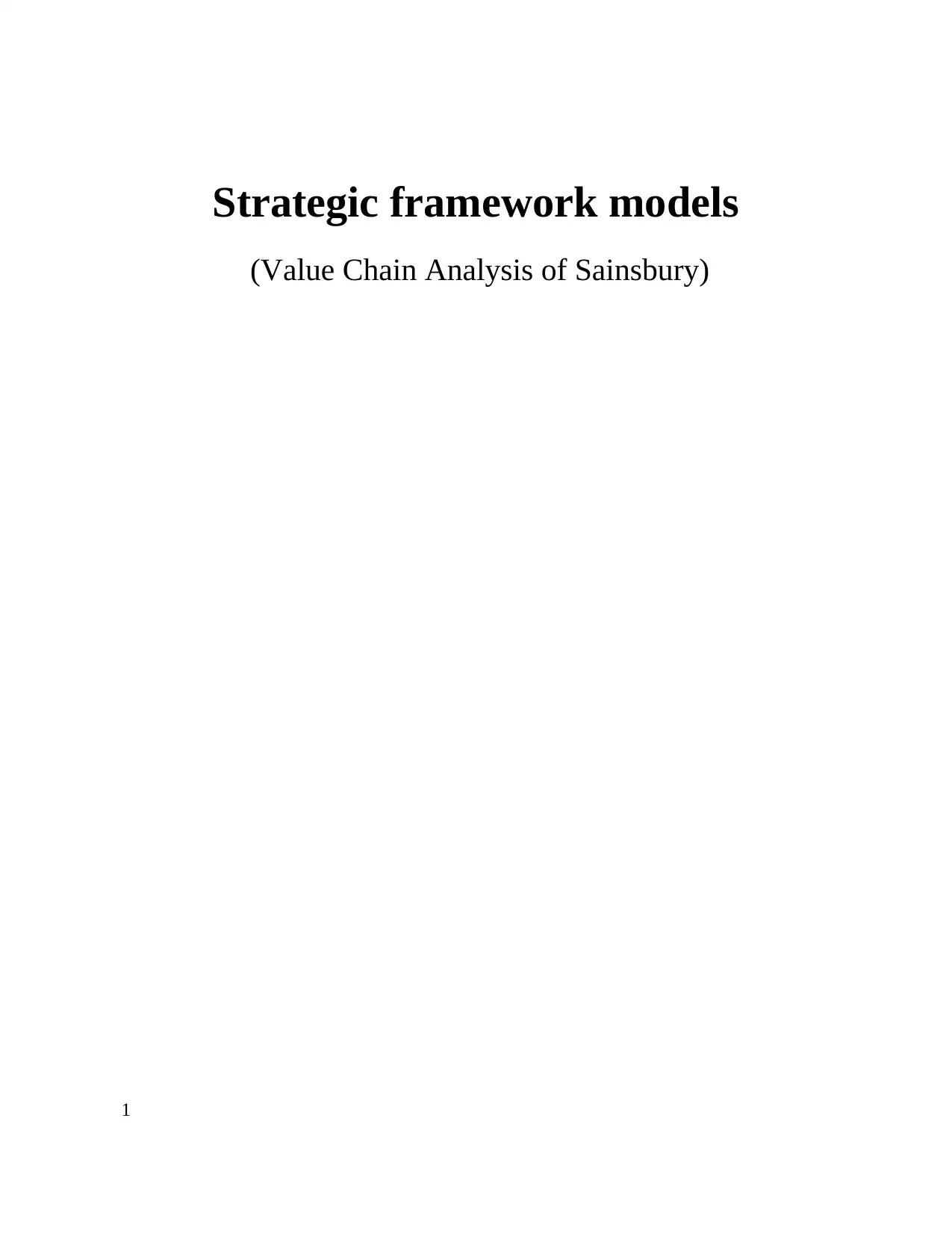
Strategic framework models
(Value Chain Analysis of Sainsbury)
1
(Value Chain Analysis of Sainsbury)
1
Paraphrase This Document
Need a fresh take? Get an instant paraphrase of this document with our AI Paraphraser
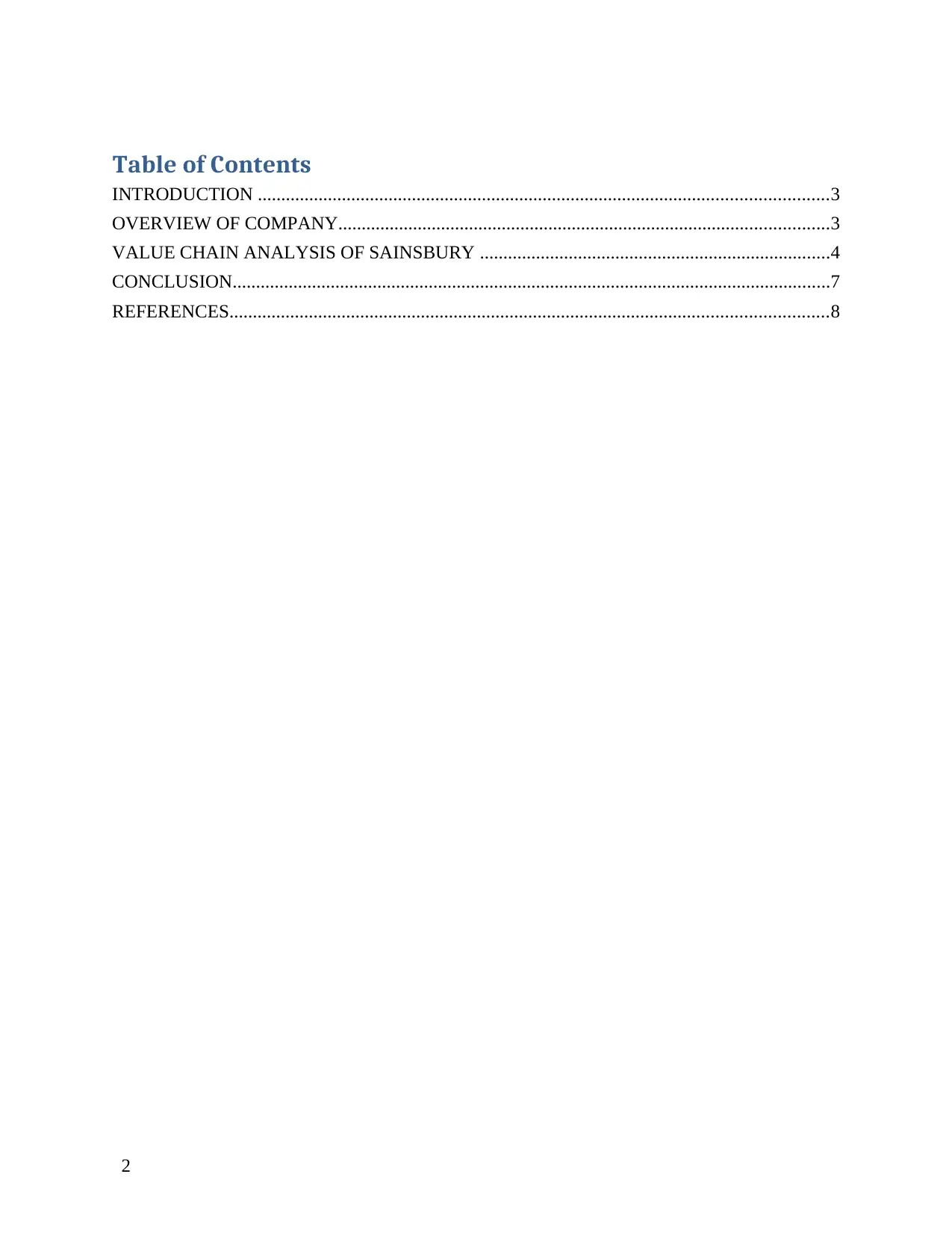
Table of Contents
INTRODUCTION ..........................................................................................................................3
OVERVIEW OF COMPANY.........................................................................................................3
VALUE CHAIN ANALYSIS OF SAINSBURY ...........................................................................4
CONCLUSION................................................................................................................................7
REFERENCES................................................................................................................................8
2
INTRODUCTION ..........................................................................................................................3
OVERVIEW OF COMPANY.........................................................................................................3
VALUE CHAIN ANALYSIS OF SAINSBURY ...........................................................................4
CONCLUSION................................................................................................................................7
REFERENCES................................................................................................................................8
2
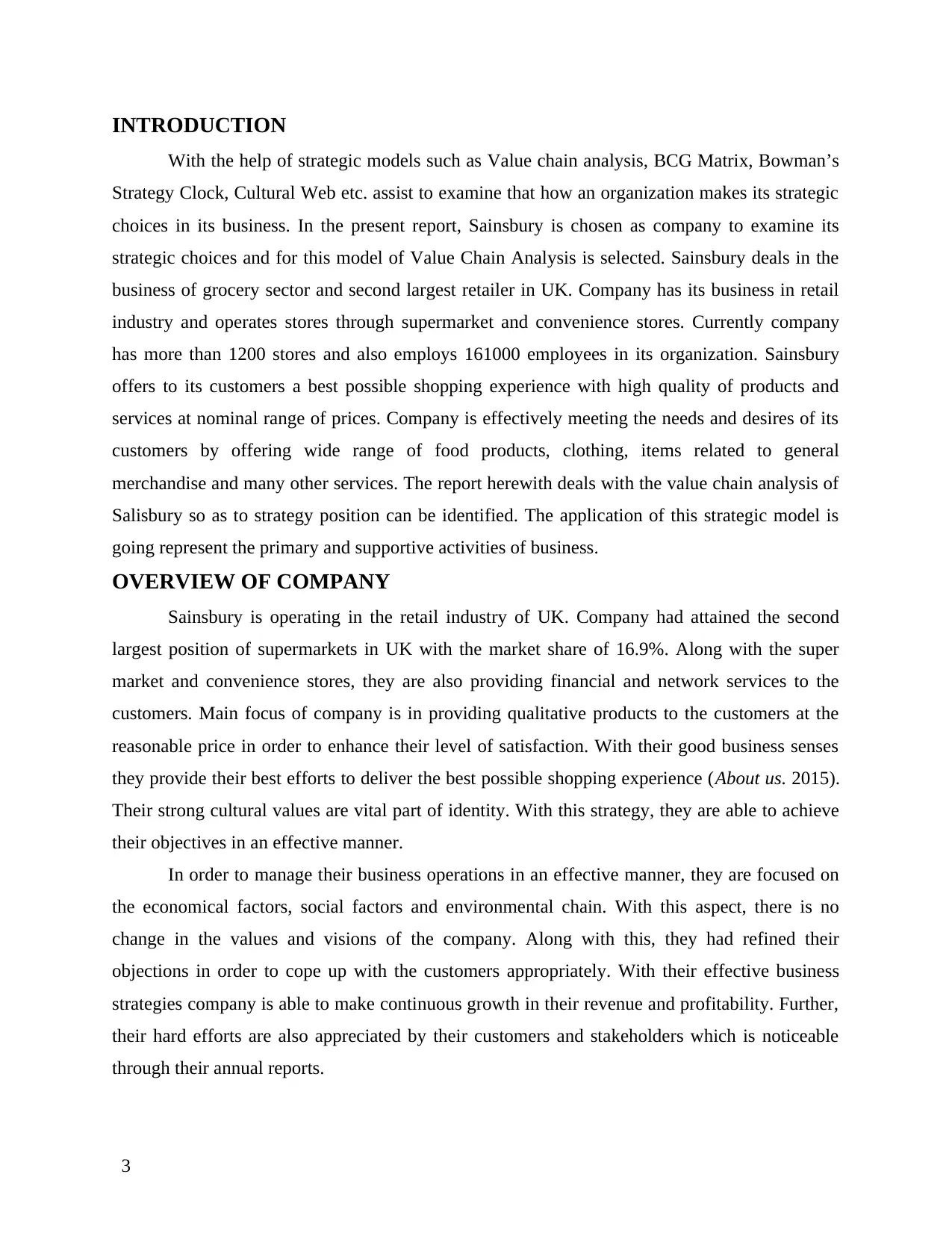
INTRODUCTION
With the help of strategic models such as Value chain analysis, BCG Matrix, Bowman’s
Strategy Clock, Cultural Web etc. assist to examine that how an organization makes its strategic
choices in its business. In the present report, Sainsbury is chosen as company to examine its
strategic choices and for this model of Value Chain Analysis is selected. Sainsbury deals in the
business of grocery sector and second largest retailer in UK. Company has its business in retail
industry and operates stores through supermarket and convenience stores. Currently company
has more than 1200 stores and also employs 161000 employees in its organization. Sainsbury
offers to its customers a best possible shopping experience with high quality of products and
services at nominal range of prices. Company is effectively meeting the needs and desires of its
customers by offering wide range of food products, clothing, items related to general
merchandise and many other services. The report herewith deals with the value chain analysis of
Salisbury so as to strategy position can be identified. The application of this strategic model is
going represent the primary and supportive activities of business.
OVERVIEW OF COMPANY
Sainsbury is operating in the retail industry of UK. Company had attained the second
largest position of supermarkets in UK with the market share of 16.9%. Along with the super
market and convenience stores, they are also providing financial and network services to the
customers. Main focus of company is in providing qualitative products to the customers at the
reasonable price in order to enhance their level of satisfaction. With their good business senses
they provide their best efforts to deliver the best possible shopping experience (About us. 2015).
Their strong cultural values are vital part of identity. With this strategy, they are able to achieve
their objectives in an effective manner.
In order to manage their business operations in an effective manner, they are focused on
the economical factors, social factors and environmental chain. With this aspect, there is no
change in the values and visions of the company. Along with this, they had refined their
objections in order to cope up with the customers appropriately. With their effective business
strategies company is able to make continuous growth in their revenue and profitability. Further,
their hard efforts are also appreciated by their customers and stakeholders which is noticeable
through their annual reports.
3
With the help of strategic models such as Value chain analysis, BCG Matrix, Bowman’s
Strategy Clock, Cultural Web etc. assist to examine that how an organization makes its strategic
choices in its business. In the present report, Sainsbury is chosen as company to examine its
strategic choices and for this model of Value Chain Analysis is selected. Sainsbury deals in the
business of grocery sector and second largest retailer in UK. Company has its business in retail
industry and operates stores through supermarket and convenience stores. Currently company
has more than 1200 stores and also employs 161000 employees in its organization. Sainsbury
offers to its customers a best possible shopping experience with high quality of products and
services at nominal range of prices. Company is effectively meeting the needs and desires of its
customers by offering wide range of food products, clothing, items related to general
merchandise and many other services. The report herewith deals with the value chain analysis of
Salisbury so as to strategy position can be identified. The application of this strategic model is
going represent the primary and supportive activities of business.
OVERVIEW OF COMPANY
Sainsbury is operating in the retail industry of UK. Company had attained the second
largest position of supermarkets in UK with the market share of 16.9%. Along with the super
market and convenience stores, they are also providing financial and network services to the
customers. Main focus of company is in providing qualitative products to the customers at the
reasonable price in order to enhance their level of satisfaction. With their good business senses
they provide their best efforts to deliver the best possible shopping experience (About us. 2015).
Their strong cultural values are vital part of identity. With this strategy, they are able to achieve
their objectives in an effective manner.
In order to manage their business operations in an effective manner, they are focused on
the economical factors, social factors and environmental chain. With this aspect, there is no
change in the values and visions of the company. Along with this, they had refined their
objections in order to cope up with the customers appropriately. With their effective business
strategies company is able to make continuous growth in their revenue and profitability. Further,
their hard efforts are also appreciated by their customers and stakeholders which is noticeable
through their annual reports.
3
⊘ This is a preview!⊘
Do you want full access?
Subscribe today to unlock all pages.

Trusted by 1+ million students worldwide
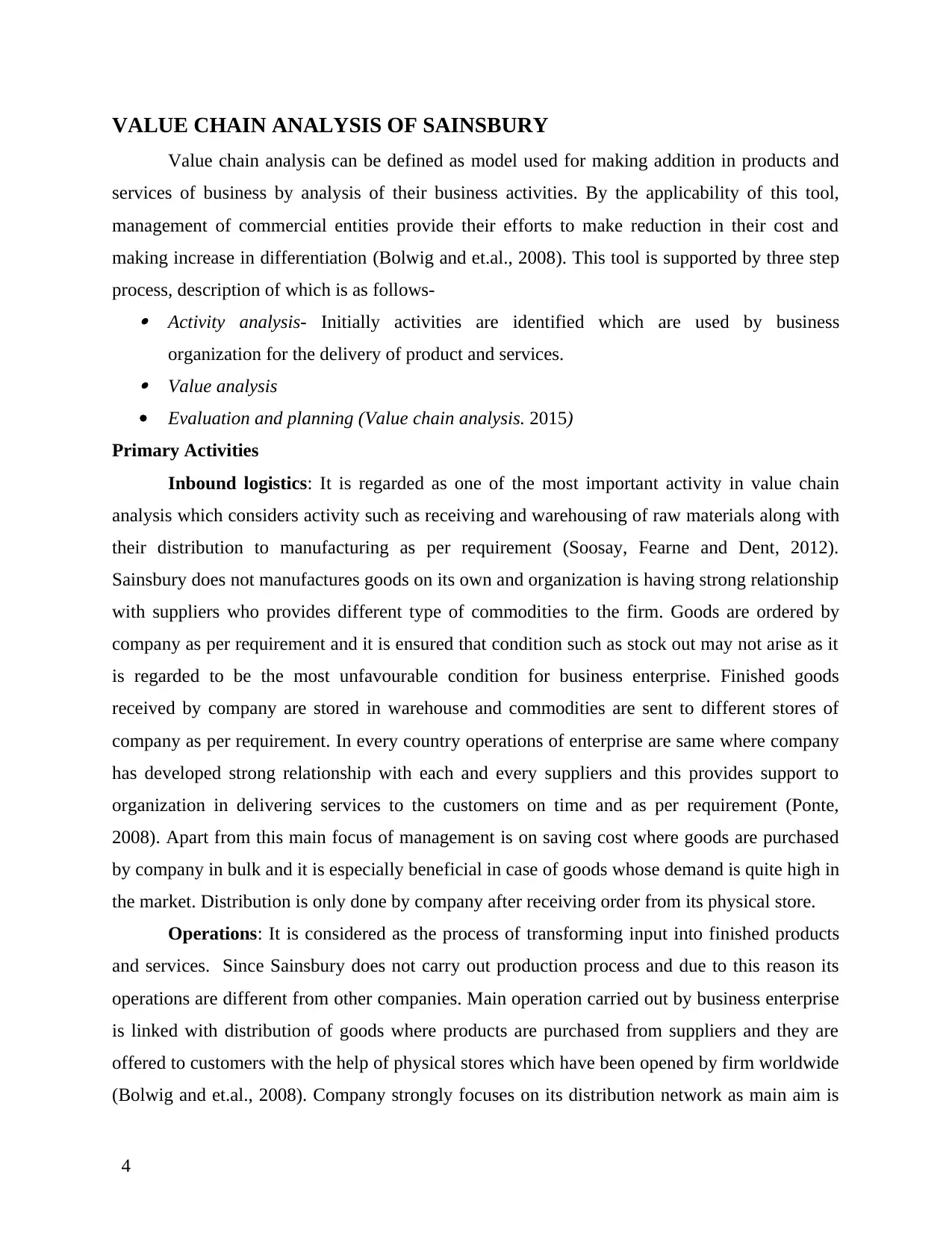
VALUE CHAIN ANALYSIS OF SAINSBURY
Value chain analysis can be defined as model used for making addition in products and
services of business by analysis of their business activities. By the applicability of this tool,
management of commercial entities provide their efforts to make reduction in their cost and
making increase in differentiation (Bolwig and et.al., 2008). This tool is supported by three step
process, description of which is as follows- Activity analysis- Initially activities are identified which are used by business
organization for the delivery of product and services. Value analysis
Evaluation and planning (Value chain analysis. 2015)
Primary Activities
Inbound logistics: It is regarded as one of the most important activity in value chain
analysis which considers activity such as receiving and warehousing of raw materials along with
their distribution to manufacturing as per requirement (Soosay, Fearne and Dent, 2012).
Sainsbury does not manufactures goods on its own and organization is having strong relationship
with suppliers who provides different type of commodities to the firm. Goods are ordered by
company as per requirement and it is ensured that condition such as stock out may not arise as it
is regarded to be the most unfavourable condition for business enterprise. Finished goods
received by company are stored in warehouse and commodities are sent to different stores of
company as per requirement. In every country operations of enterprise are same where company
has developed strong relationship with each and every suppliers and this provides support to
organization in delivering services to the customers on time and as per requirement (Ponte,
2008). Apart from this main focus of management is on saving cost where goods are purchased
by company in bulk and it is especially beneficial in case of goods whose demand is quite high in
the market. Distribution is only done by company after receiving order from its physical store.
Operations: It is considered as the process of transforming input into finished products
and services. Since Sainsbury does not carry out production process and due to this reason its
operations are different from other companies. Main operation carried out by business enterprise
is linked with distribution of goods where products are purchased from suppliers and they are
offered to customers with the help of physical stores which have been opened by firm worldwide
(Bolwig and et.al., 2008). Company strongly focuses on its distribution network as main aim is
4
Value chain analysis can be defined as model used for making addition in products and
services of business by analysis of their business activities. By the applicability of this tool,
management of commercial entities provide their efforts to make reduction in their cost and
making increase in differentiation (Bolwig and et.al., 2008). This tool is supported by three step
process, description of which is as follows- Activity analysis- Initially activities are identified which are used by business
organization for the delivery of product and services. Value analysis
Evaluation and planning (Value chain analysis. 2015)
Primary Activities
Inbound logistics: It is regarded as one of the most important activity in value chain
analysis which considers activity such as receiving and warehousing of raw materials along with
their distribution to manufacturing as per requirement (Soosay, Fearne and Dent, 2012).
Sainsbury does not manufactures goods on its own and organization is having strong relationship
with suppliers who provides different type of commodities to the firm. Goods are ordered by
company as per requirement and it is ensured that condition such as stock out may not arise as it
is regarded to be the most unfavourable condition for business enterprise. Finished goods
received by company are stored in warehouse and commodities are sent to different stores of
company as per requirement. In every country operations of enterprise are same where company
has developed strong relationship with each and every suppliers and this provides support to
organization in delivering services to the customers on time and as per requirement (Ponte,
2008). Apart from this main focus of management is on saving cost where goods are purchased
by company in bulk and it is especially beneficial in case of goods whose demand is quite high in
the market. Distribution is only done by company after receiving order from its physical store.
Operations: It is considered as the process of transforming input into finished products
and services. Since Sainsbury does not carry out production process and due to this reason its
operations are different from other companies. Main operation carried out by business enterprise
is linked with distribution of goods where products are purchased from suppliers and they are
offered to customers with the help of physical stores which have been opened by firm worldwide
(Bolwig and et.al., 2008). Company strongly focuses on its distribution network as main aim is
4
Paraphrase This Document
Need a fresh take? Get an instant paraphrase of this document with our AI Paraphraser
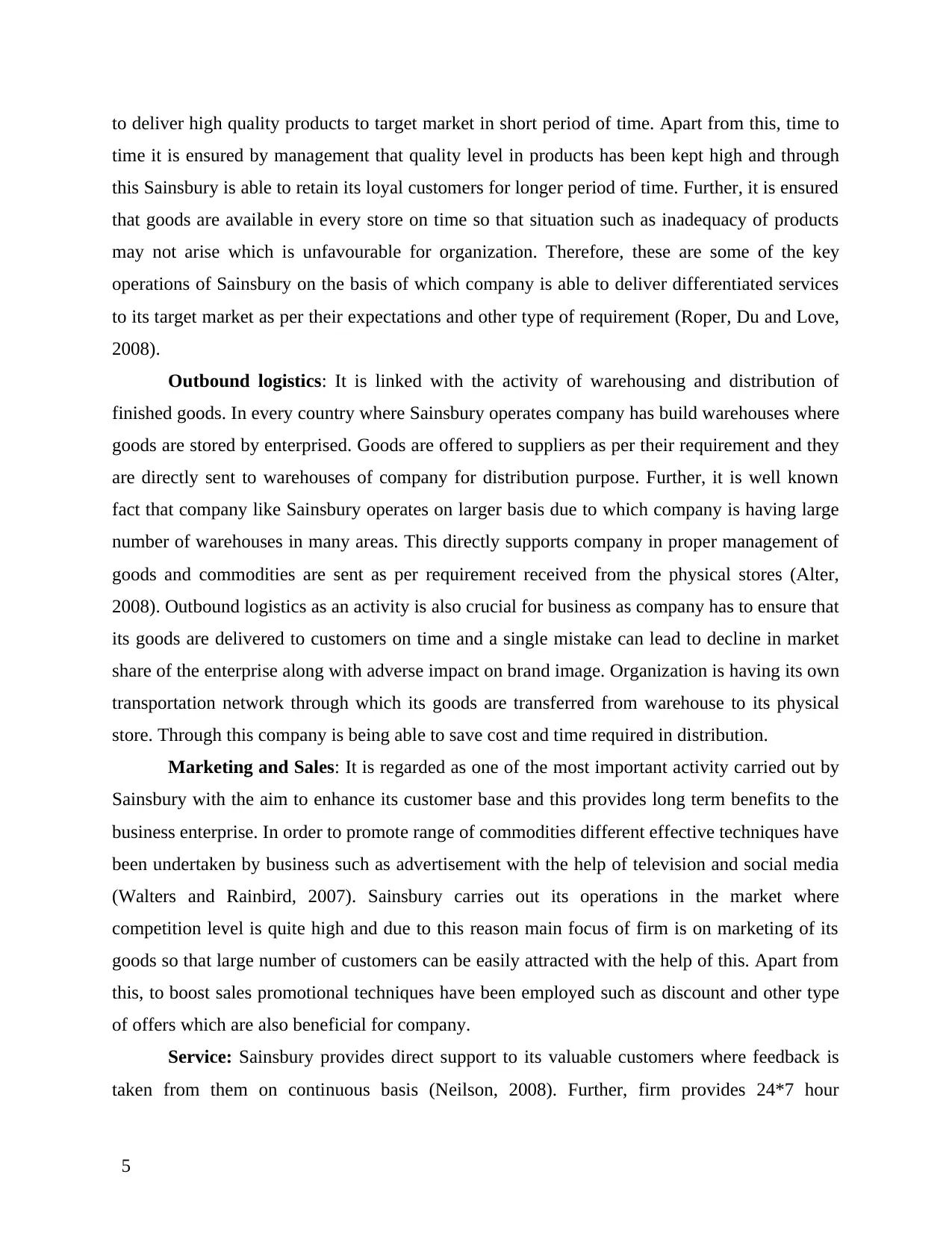
to deliver high quality products to target market in short period of time. Apart from this, time to
time it is ensured by management that quality level in products has been kept high and through
this Sainsbury is able to retain its loyal customers for longer period of time. Further, it is ensured
that goods are available in every store on time so that situation such as inadequacy of products
may not arise which is unfavourable for organization. Therefore, these are some of the key
operations of Sainsbury on the basis of which company is able to deliver differentiated services
to its target market as per their expectations and other type of requirement (Roper, Du and Love,
2008).
Outbound logistics: It is linked with the activity of warehousing and distribution of
finished goods. In every country where Sainsbury operates company has build warehouses where
goods are stored by enterprised. Goods are offered to suppliers as per their requirement and they
are directly sent to warehouses of company for distribution purpose. Further, it is well known
fact that company like Sainsbury operates on larger basis due to which company is having large
number of warehouses in many areas. This directly supports company in proper management of
goods and commodities are sent as per requirement received from the physical stores (Alter,
2008). Outbound logistics as an activity is also crucial for business as company has to ensure that
its goods are delivered to customers on time and a single mistake can lead to decline in market
share of the enterprise along with adverse impact on brand image. Organization is having its own
transportation network through which its goods are transferred from warehouse to its physical
store. Through this company is being able to save cost and time required in distribution.
Marketing and Sales: It is regarded as one of the most important activity carried out by
Sainsbury with the aim to enhance its customer base and this provides long term benefits to the
business enterprise. In order to promote range of commodities different effective techniques have
been undertaken by business such as advertisement with the help of television and social media
(Walters and Rainbird, 2007). Sainsbury carries out its operations in the market where
competition level is quite high and due to this reason main focus of firm is on marketing of its
goods so that large number of customers can be easily attracted with the help of this. Apart from
this, to boost sales promotional techniques have been employed such as discount and other type
of offers which are also beneficial for company.
Service: Sainsbury provides direct support to its valuable customers where feedback is
taken from them on continuous basis (Neilson, 2008). Further, firm provides 24*7 hour
5
time it is ensured by management that quality level in products has been kept high and through
this Sainsbury is able to retain its loyal customers for longer period of time. Further, it is ensured
that goods are available in every store on time so that situation such as inadequacy of products
may not arise which is unfavourable for organization. Therefore, these are some of the key
operations of Sainsbury on the basis of which company is able to deliver differentiated services
to its target market as per their expectations and other type of requirement (Roper, Du and Love,
2008).
Outbound logistics: It is linked with the activity of warehousing and distribution of
finished goods. In every country where Sainsbury operates company has build warehouses where
goods are stored by enterprised. Goods are offered to suppliers as per their requirement and they
are directly sent to warehouses of company for distribution purpose. Further, it is well known
fact that company like Sainsbury operates on larger basis due to which company is having large
number of warehouses in many areas. This directly supports company in proper management of
goods and commodities are sent as per requirement received from the physical stores (Alter,
2008). Outbound logistics as an activity is also crucial for business as company has to ensure that
its goods are delivered to customers on time and a single mistake can lead to decline in market
share of the enterprise along with adverse impact on brand image. Organization is having its own
transportation network through which its goods are transferred from warehouse to its physical
store. Through this company is being able to save cost and time required in distribution.
Marketing and Sales: It is regarded as one of the most important activity carried out by
Sainsbury with the aim to enhance its customer base and this provides long term benefits to the
business enterprise. In order to promote range of commodities different effective techniques have
been undertaken by business such as advertisement with the help of television and social media
(Walters and Rainbird, 2007). Sainsbury carries out its operations in the market where
competition level is quite high and due to this reason main focus of firm is on marketing of its
goods so that large number of customers can be easily attracted with the help of this. Apart from
this, to boost sales promotional techniques have been employed such as discount and other type
of offers which are also beneficial for company.
Service: Sainsbury provides direct support to its valuable customers where feedback is
taken from them on continuous basis (Neilson, 2008). Further, firm provides 24*7 hour
5
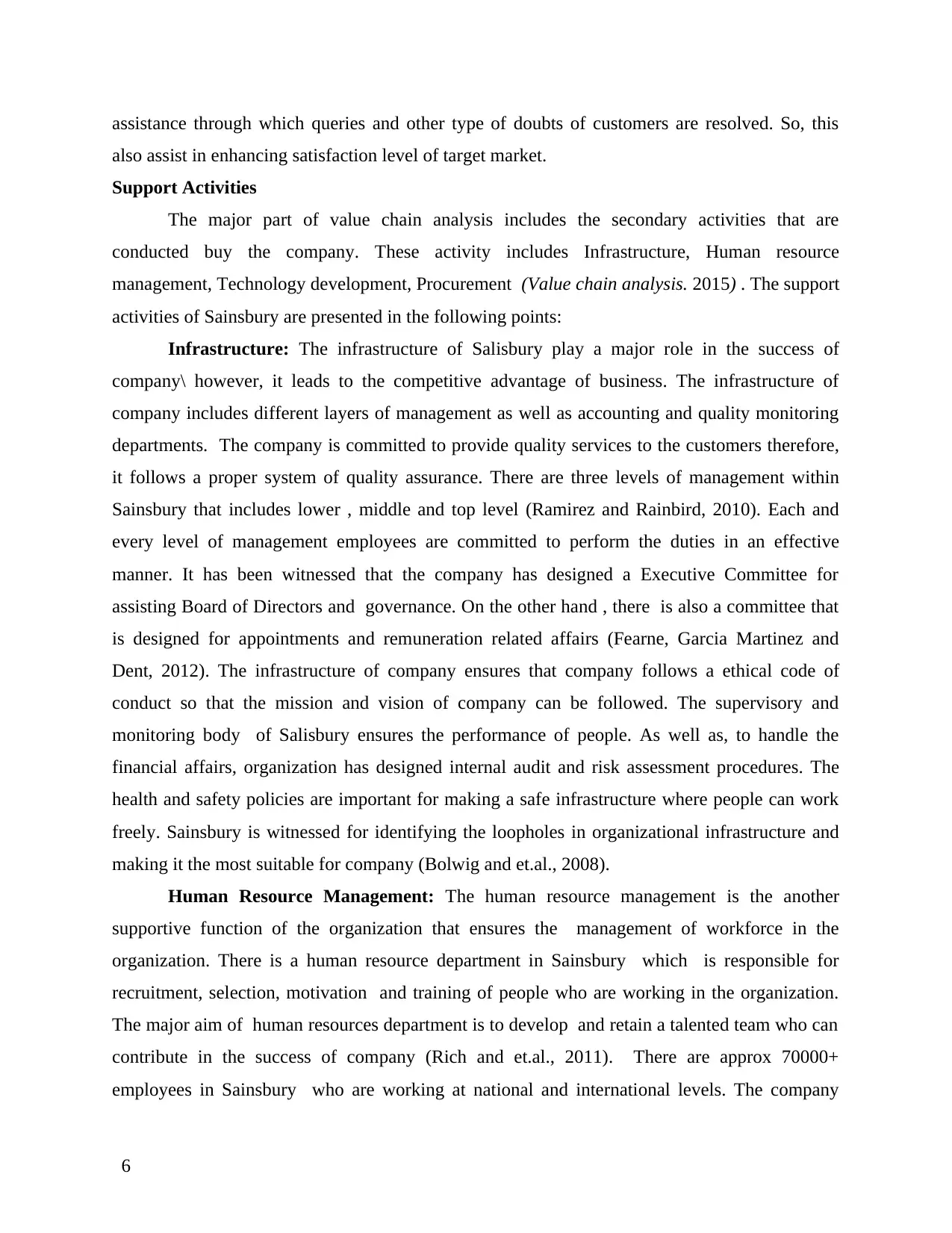
assistance through which queries and other type of doubts of customers are resolved. So, this
also assist in enhancing satisfaction level of target market.
Support Activities
The major part of value chain analysis includes the secondary activities that are
conducted buy the company. These activity includes Infrastructure, Human resource
management, Technology development, Procurement (Value chain analysis. 2015) . The support
activities of Sainsbury are presented in the following points:
Infrastructure: The infrastructure of Salisbury play a major role in the success of
company\ however, it leads to the competitive advantage of business. The infrastructure of
company includes different layers of management as well as accounting and quality monitoring
departments. The company is committed to provide quality services to the customers therefore,
it follows a proper system of quality assurance. There are three levels of management within
Sainsbury that includes lower , middle and top level (Ramirez and Rainbird, 2010). Each and
every level of management employees are committed to perform the duties in an effective
manner. It has been witnessed that the company has designed a Executive Committee for
assisting Board of Directors and governance. On the other hand , there is also a committee that
is designed for appointments and remuneration related affairs (Fearne, Garcia Martinez and
Dent, 2012). The infrastructure of company ensures that company follows a ethical code of
conduct so that the mission and vision of company can be followed. The supervisory and
monitoring body of Salisbury ensures the performance of people. As well as, to handle the
financial affairs, organization has designed internal audit and risk assessment procedures. The
health and safety policies are important for making a safe infrastructure where people can work
freely. Sainsbury is witnessed for identifying the loopholes in organizational infrastructure and
making it the most suitable for company (Bolwig and et.al., 2008).
Human Resource Management: The human resource management is the another
supportive function of the organization that ensures the management of workforce in the
organization. There is a human resource department in Sainsbury which is responsible for
recruitment, selection, motivation and training of people who are working in the organization.
The major aim of human resources department is to develop and retain a talented team who can
contribute in the success of company (Rich and et.al., 2011). There are approx 70000+
employees in Sainsbury who are working at national and international levels. The company
6
also assist in enhancing satisfaction level of target market.
Support Activities
The major part of value chain analysis includes the secondary activities that are
conducted buy the company. These activity includes Infrastructure, Human resource
management, Technology development, Procurement (Value chain analysis. 2015) . The support
activities of Sainsbury are presented in the following points:
Infrastructure: The infrastructure of Salisbury play a major role in the success of
company\ however, it leads to the competitive advantage of business. The infrastructure of
company includes different layers of management as well as accounting and quality monitoring
departments. The company is committed to provide quality services to the customers therefore,
it follows a proper system of quality assurance. There are three levels of management within
Sainsbury that includes lower , middle and top level (Ramirez and Rainbird, 2010). Each and
every level of management employees are committed to perform the duties in an effective
manner. It has been witnessed that the company has designed a Executive Committee for
assisting Board of Directors and governance. On the other hand , there is also a committee that
is designed for appointments and remuneration related affairs (Fearne, Garcia Martinez and
Dent, 2012). The infrastructure of company ensures that company follows a ethical code of
conduct so that the mission and vision of company can be followed. The supervisory and
monitoring body of Salisbury ensures the performance of people. As well as, to handle the
financial affairs, organization has designed internal audit and risk assessment procedures. The
health and safety policies are important for making a safe infrastructure where people can work
freely. Sainsbury is witnessed for identifying the loopholes in organizational infrastructure and
making it the most suitable for company (Bolwig and et.al., 2008).
Human Resource Management: The human resource management is the another
supportive function of the organization that ensures the management of workforce in the
organization. There is a human resource department in Sainsbury which is responsible for
recruitment, selection, motivation and training of people who are working in the organization.
The major aim of human resources department is to develop and retain a talented team who can
contribute in the success of company (Rich and et.al., 2011). There are approx 70000+
employees in Sainsbury who are working at national and international levels. The company
6
⊘ This is a preview!⊘
Do you want full access?
Subscribe today to unlock all pages.

Trusted by 1+ million students worldwide
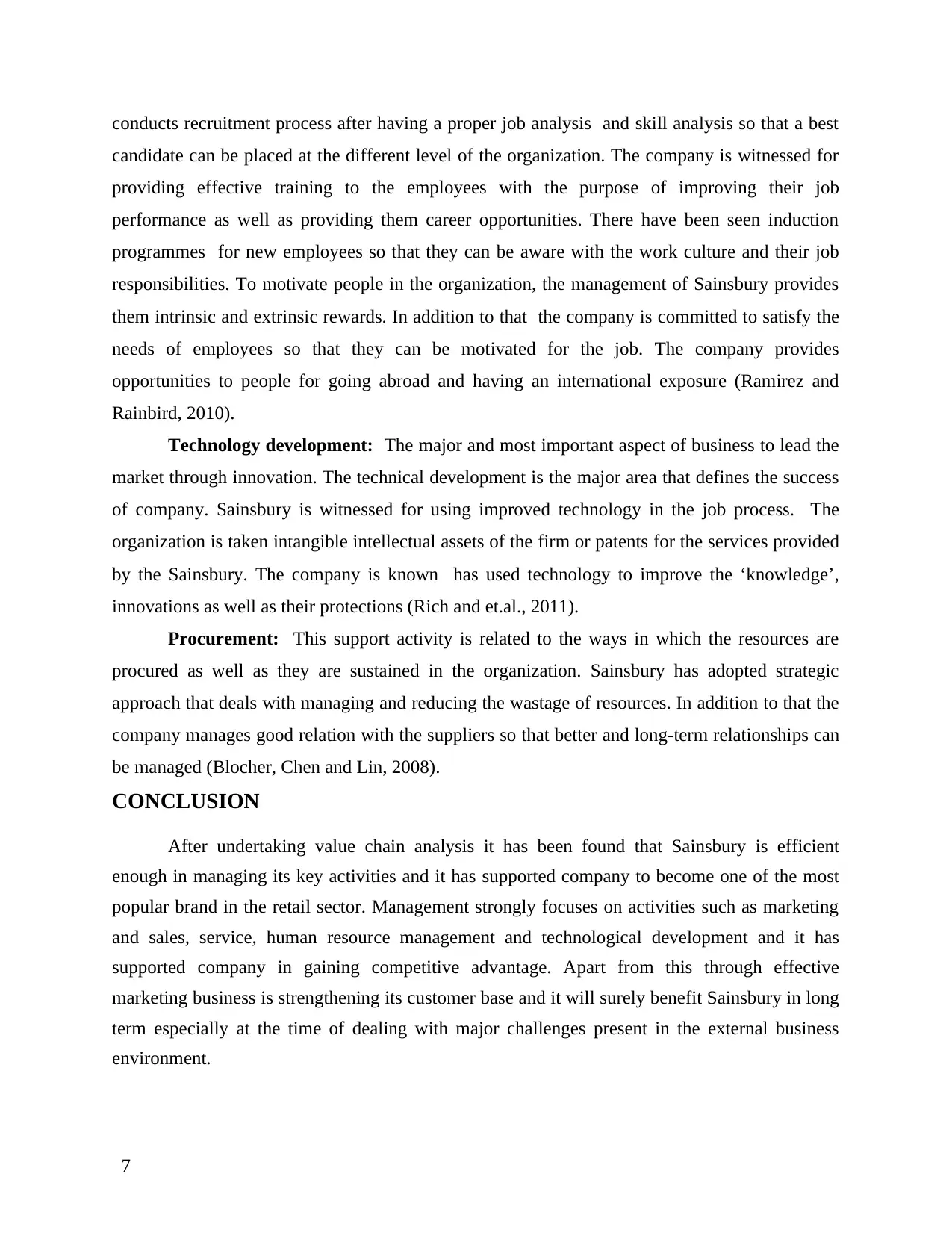
conducts recruitment process after having a proper job analysis and skill analysis so that a best
candidate can be placed at the different level of the organization. The company is witnessed for
providing effective training to the employees with the purpose of improving their job
performance as well as providing them career opportunities. There have been seen induction
programmes for new employees so that they can be aware with the work culture and their job
responsibilities. To motivate people in the organization, the management of Sainsbury provides
them intrinsic and extrinsic rewards. In addition to that the company is committed to satisfy the
needs of employees so that they can be motivated for the job. The company provides
opportunities to people for going abroad and having an international exposure (Ramirez and
Rainbird, 2010).
Technology development: The major and most important aspect of business to lead the
market through innovation. The technical development is the major area that defines the success
of company. Sainsbury is witnessed for using improved technology in the job process. The
organization is taken intangible intellectual assets of the firm or patents for the services provided
by the Sainsbury. The company is known has used technology to improve the ‘knowledge’,
innovations as well as their protections (Rich and et.al., 2011).
Procurement: This support activity is related to the ways in which the resources are
procured as well as they are sustained in the organization. Sainsbury has adopted strategic
approach that deals with managing and reducing the wastage of resources. In addition to that the
company manages good relation with the suppliers so that better and long-term relationships can
be managed (Blocher, Chen and Lin, 2008).
CONCLUSION
After undertaking value chain analysis it has been found that Sainsbury is efficient
enough in managing its key activities and it has supported company to become one of the most
popular brand in the retail sector. Management strongly focuses on activities such as marketing
and sales, service, human resource management and technological development and it has
supported company in gaining competitive advantage. Apart from this through effective
marketing business is strengthening its customer base and it will surely benefit Sainsbury in long
term especially at the time of dealing with major challenges present in the external business
environment.
7
candidate can be placed at the different level of the organization. The company is witnessed for
providing effective training to the employees with the purpose of improving their job
performance as well as providing them career opportunities. There have been seen induction
programmes for new employees so that they can be aware with the work culture and their job
responsibilities. To motivate people in the organization, the management of Sainsbury provides
them intrinsic and extrinsic rewards. In addition to that the company is committed to satisfy the
needs of employees so that they can be motivated for the job. The company provides
opportunities to people for going abroad and having an international exposure (Ramirez and
Rainbird, 2010).
Technology development: The major and most important aspect of business to lead the
market through innovation. The technical development is the major area that defines the success
of company. Sainsbury is witnessed for using improved technology in the job process. The
organization is taken intangible intellectual assets of the firm or patents for the services provided
by the Sainsbury. The company is known has used technology to improve the ‘knowledge’,
innovations as well as their protections (Rich and et.al., 2011).
Procurement: This support activity is related to the ways in which the resources are
procured as well as they are sustained in the organization. Sainsbury has adopted strategic
approach that deals with managing and reducing the wastage of resources. In addition to that the
company manages good relation with the suppliers so that better and long-term relationships can
be managed (Blocher, Chen and Lin, 2008).
CONCLUSION
After undertaking value chain analysis it has been found that Sainsbury is efficient
enough in managing its key activities and it has supported company to become one of the most
popular brand in the retail sector. Management strongly focuses on activities such as marketing
and sales, service, human resource management and technological development and it has
supported company in gaining competitive advantage. Apart from this through effective
marketing business is strengthening its customer base and it will surely benefit Sainsbury in long
term especially at the time of dealing with major challenges present in the external business
environment.
7
Paraphrase This Document
Need a fresh take? Get an instant paraphrase of this document with our AI Paraphraser
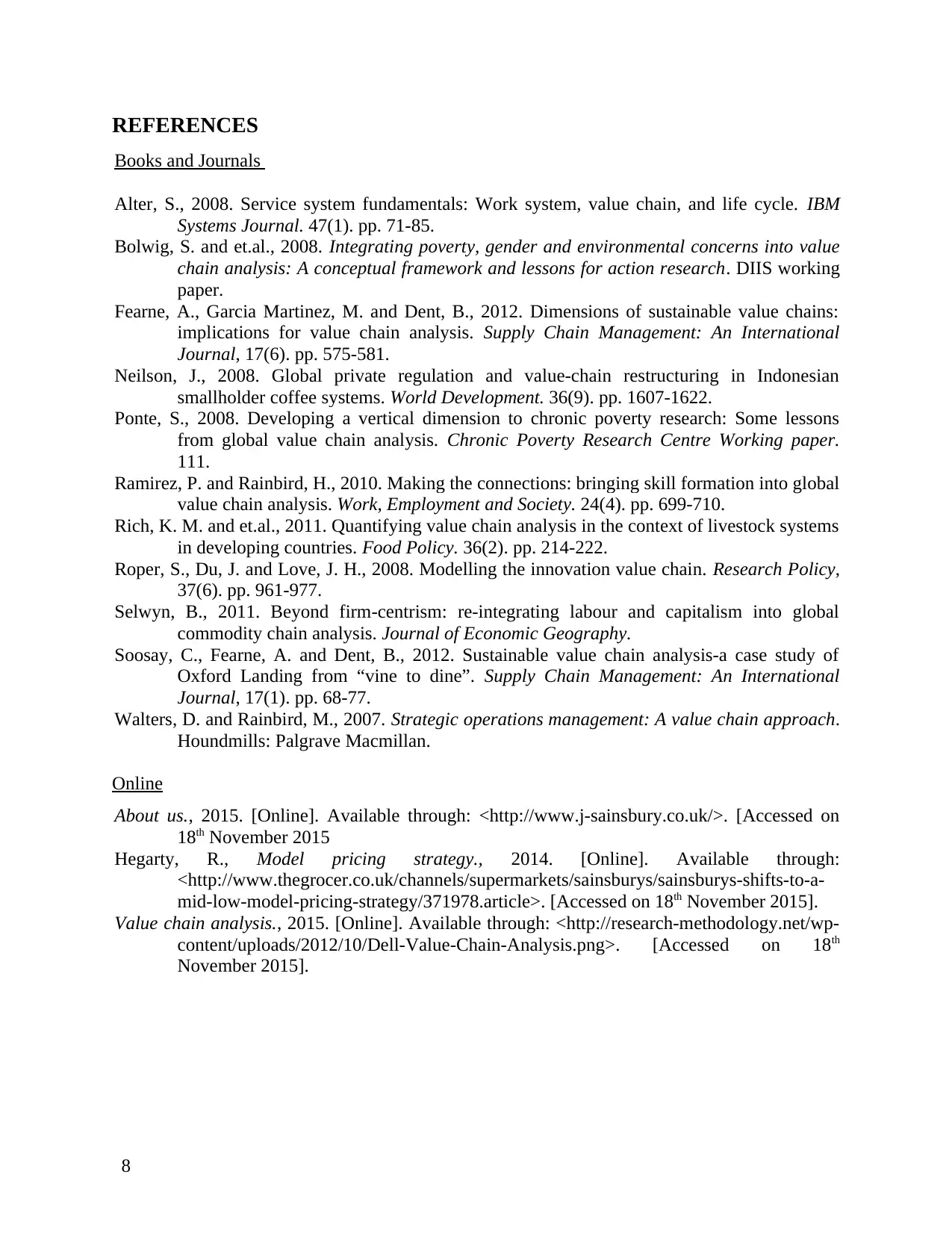
REFERENCES
Books and Journals
Alter, S., 2008. Service system fundamentals: Work system, value chain, and life cycle. IBM
Systems Journal. 47(1). pp. 71-85.
Bolwig, S. and et.al., 2008. Integrating poverty, gender and environmental concerns into value
chain analysis: A conceptual framework and lessons for action research. DIIS working
paper.
Fearne, A., Garcia Martinez, M. and Dent, B., 2012. Dimensions of sustainable value chains:
implications for value chain analysis. Supply Chain Management: An International
Journal, 17(6). pp. 575-581.
Neilson, J., 2008. Global private regulation and value-chain restructuring in Indonesian
smallholder coffee systems. World Development. 36(9). pp. 1607-1622.
Ponte, S., 2008. Developing a vertical dimension to chronic poverty research: Some lessons
from global value chain analysis. Chronic Poverty Research Centre Working paper.
111.
Ramirez, P. and Rainbird, H., 2010. Making the connections: bringing skill formation into global
value chain analysis. Work, Employment and Society. 24(4). pp. 699-710.
Rich, K. M. and et.al., 2011. Quantifying value chain analysis in the context of livestock systems
in developing countries. Food Policy. 36(2). pp. 214-222.
Roper, S., Du, J. and Love, J. H., 2008. Modelling the innovation value chain. Research Policy,
37(6). pp. 961-977.
Selwyn, B., 2011. Beyond firm-centrism: re-integrating labour and capitalism into global
commodity chain analysis. Journal of Economic Geography.
Soosay, C., Fearne, A. and Dent, B., 2012. Sustainable value chain analysis-a case study of
Oxford Landing from “vine to dine”. Supply Chain Management: An International
Journal, 17(1). pp. 68-77.
Walters, D. and Rainbird, M., 2007. Strategic operations management: A value chain approach.
Houndmills: Palgrave Macmillan.
Online
About us., 2015. [Online]. Available through: <http://www.j-sainsbury.co.uk/>. [Accessed on
18th November 2015
Hegarty, R., Model pricing strategy., 2014. [Online]. Available through:
<http://www.thegrocer.co.uk/channels/supermarkets/sainsburys/sainsburys-shifts-to-a-
mid-low-model-pricing-strategy/371978.article>. [Accessed on 18th November 2015].
Value chain analysis., 2015. [Online]. Available through: <http://research-methodology.net/wp-
content/uploads/2012/10/Dell-Value-Chain-Analysis.png>. [Accessed on 18th
November 2015].
8
Books and Journals
Alter, S., 2008. Service system fundamentals: Work system, value chain, and life cycle. IBM
Systems Journal. 47(1). pp. 71-85.
Bolwig, S. and et.al., 2008. Integrating poverty, gender and environmental concerns into value
chain analysis: A conceptual framework and lessons for action research. DIIS working
paper.
Fearne, A., Garcia Martinez, M. and Dent, B., 2012. Dimensions of sustainable value chains:
implications for value chain analysis. Supply Chain Management: An International
Journal, 17(6). pp. 575-581.
Neilson, J., 2008. Global private regulation and value-chain restructuring in Indonesian
smallholder coffee systems. World Development. 36(9). pp. 1607-1622.
Ponte, S., 2008. Developing a vertical dimension to chronic poverty research: Some lessons
from global value chain analysis. Chronic Poverty Research Centre Working paper.
111.
Ramirez, P. and Rainbird, H., 2010. Making the connections: bringing skill formation into global
value chain analysis. Work, Employment and Society. 24(4). pp. 699-710.
Rich, K. M. and et.al., 2011. Quantifying value chain analysis in the context of livestock systems
in developing countries. Food Policy. 36(2). pp. 214-222.
Roper, S., Du, J. and Love, J. H., 2008. Modelling the innovation value chain. Research Policy,
37(6). pp. 961-977.
Selwyn, B., 2011. Beyond firm-centrism: re-integrating labour and capitalism into global
commodity chain analysis. Journal of Economic Geography.
Soosay, C., Fearne, A. and Dent, B., 2012. Sustainable value chain analysis-a case study of
Oxford Landing from “vine to dine”. Supply Chain Management: An International
Journal, 17(1). pp. 68-77.
Walters, D. and Rainbird, M., 2007. Strategic operations management: A value chain approach.
Houndmills: Palgrave Macmillan.
Online
About us., 2015. [Online]. Available through: <http://www.j-sainsbury.co.uk/>. [Accessed on
18th November 2015
Hegarty, R., Model pricing strategy., 2014. [Online]. Available through:
<http://www.thegrocer.co.uk/channels/supermarkets/sainsburys/sainsburys-shifts-to-a-
mid-low-model-pricing-strategy/371978.article>. [Accessed on 18th November 2015].
Value chain analysis., 2015. [Online]. Available through: <http://research-methodology.net/wp-
content/uploads/2012/10/Dell-Value-Chain-Analysis.png>. [Accessed on 18th
November 2015].
8
1 out of 8
Related Documents
Your All-in-One AI-Powered Toolkit for Academic Success.
+13062052269
info@desklib.com
Available 24*7 on WhatsApp / Email
![[object Object]](/_next/static/media/star-bottom.7253800d.svg)
Unlock your academic potential
Copyright © 2020–2025 A2Z Services. All Rights Reserved. Developed and managed by ZUCOL.





